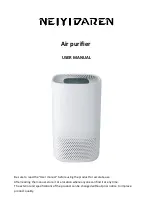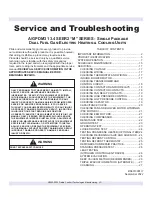
351579-YTS-B-0608
Johnson Controls Unitary Products
37
The RAH sensor, if available in addition to the OAH sensor,
allows use of Differential Enthalpy method for deciding on free
cooling availability.
See paragraphs OAH Sensor Enable and RAH Sensor Enable
in Settable Parameters, Table 5 in this document.
If the selected method is using an enthalpy, the enthalpy is
calculated in the controller from sensed temperature and
humidity of the respective air stream.
Differential Enthalpy Method
: is set by parameter and used
only when sensors for Outdoor Air temperature, Outdoor Air
humidity, Return Air temperature and Return Air humidity are all
installed and reliable.
Outside Enthalpy Method
: will be configured by setting ON
the parameter for the Outdoor Humidity Sensor [OAH], and will
be the default if the unit defined as Differential Enthalpy cannot
read the Return Air Humidity sensor.
Outside Temperature Method
: will be self-configured and
used only when differential enthalpy or outside enthalpy
methods are not available, and sensor for Outside Air
temperature is installed and reliable.
Economizer is suitable when OAT is less than SAT se
10 °F. Use a 2 °F differential on both sides of this limit. As the
SAT setpoint value, use only one of the programmed 1
st
or 2
nd
stage economizer setpoints (depending on what cooling stage
is called), not any “transient” setpoints that may be temporarily
used during process of staging. Note that this rule does not
reflect any consideration of geographical location and weather
conditions, but rather reflects the average expected SAT
temperature drop obtained from DX cooling stages, i.e. the
highest outdoor air temperature that the DX cooling can still
reliably reduce to the SAT setpoint
Outside Enthalpy Method:
Economizer is suitable when OA
Enthalpy is less than Outside Enthalpy number AND OAT is less
than SAT se 10 °F: Use a 2 °F and 1 BTU/LB differentials
respectively on both sides of these limits. The Enthalpy number
is a programmed parameter (range 22-40 BTU/LB, default 30
BTU/LB. The Enthalpy Number can be viewed as the maximum
outdoor air enthalpy with which the outside air can still be
considered suitable for DX cooling, or, in comparison to the
Differential Enthalpy Method described below, as a “best guess”
on actual return air enthalpy (which in this method is not being
sensed). The temperature limit reflects the average expected
SAT temperature drop obtained from DX cooling stages.
Differential Enthalpy Method:
Economizer is suitable when
OA Enthalpy is less than the RA Enthalpy AND OAT is less than
SAT setpoint plus 10 °F (+/- 2
°
and 1 BTU/LB): Use a 2 °F and
1 BTU/LB differentials respectively on both sides of these limits.
This is similar to the Outside Enthalpy method, except instead
of a programmed Enthalpy Number, an actually sensed return
air enthalpy is used.
SAT Control with Economizer
If the economizer is “suitable” (free cooling is available) and
cooling is required (the unit is not in satisfied state), the
algorithm will be active and modulate economizer position in
order to control SAT to the active SAT setpoint. If the
economizer is not suitable, the algorithm is deactivated and the
economizer is placed at its programmed minimum position. The
economizer control algorithm will typically be cycled ON/OFF
several times an hour (will be activated and deactivated) under
control of a zone thermostat, or a zone sensor. A zone control
algorithm will activate the economizer algorithm when cooling is
required, and will switch between Economizer 1
st
and 2
nd
stage SAT setpoints, and will deactivate the economizer
algorithm when the zone is satisfied.
The PI algorithm is direct acting. This economizer control
algorithm is always active during economizer operation (as long
as economizer is “suitable”) and will control SAT to an active
(1
st
or 2
nd
stage) Economizer setpoint. This means that this
control loop not only modulates the Outside Air damper open to
add free cooling and decrease mixed air temperature to
maintain SAT at setpoint, but, when DX cooling is running, also
may modulate the Outside Air damper closed to increase mixed
air temperature (use more return air) and thus add load on the
DX coil to maintain SAT at setpoint (“economizer loading”). This
represents a trade-off between energy and compressor cycling.
Control of compressors with Economizer
Compressors are turned ON / OFF individually, regardless of
grouping them into “stages”. The stage groups are used only for
control of compressors with external signals, such as from a
thermostat.
Turning ON of compressor #1:
Never operate compression if the Economizer can maintain the
SAT setpoint with free cooling. If no compressors are on, and
the economizer controller is saturated High (i.e. the economizer
is 100% open and can no longer maintain the SAT setpoint by
just free cooling),
• Temporarily override SAT setpoint to increase it by 5 °F
• When the SAT is within 0.5 °F of this temporary setpoint,
turn on compressor #1
• Resume SAT control at active setpoint
This is done in order to read and store the SAT temperature
differential (drop) due to turning on compressor #1, while
assuring that turning it on will not drop the SAT below
compressor #1 trip point (where the Excessive SAT control
would turn it off again). The same staging sequence is used for
the remaining compressors (see below). Note that the standard
5 minute delay before monitoring SAT after a compressor is
turned on, or off, applies here also.








































